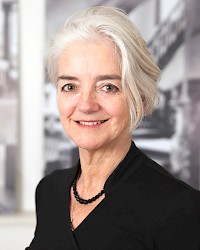Vita
Author, Blackout: Reinventing Women for Wartime British Cinema (Princeton University Press, 1991); Editor, The Red Velvet Seat: Women’s Writings on the First Fifty Years of Cinema (Verso, 2007). Member of the National Film Preservation Board, Library of Congress. Holder of Junior Research Fellowship at the University of Oxford, a J. P. Getty Postdoctoral Fellowship, fellowships at the Remarque Institute, New York University, and the Internationales Forschungscentrum Kulturwissenschaften, Vienna, as well as a National Endowment for the Arts National Service Award, and a National Endowment for the Humanities Grant. Guest Professorships at University of Vienna and Harvard University.
B.A. Fine Arts, Leeds (1979); M.Phil., Ph.D., Yale (1986) Dated from 2019
Fields of Research
My intellectual interests span the fields of art history, cinema studies, and women’s history. My scholarship has always drawn on a wide range of visual sources, from posters and paintings to fashion design and films, in order to understand the mechanisms of key cultural questions. My first book, Blackout: Reinventing Women for Wartime British Cinema, studied the impact of wartime privations on the film screen, and particularly the role that womanhood played in representing the nation in crisis. Since that time I have focused much of my attention on the silent film era, analyzing its innovative aesthetics, its infatuation with things Egyptian, its opportunities for both leisure and work for women, and its engagement with scientific research and education. My articles “Haptical Cinema” and “How the Cinema Contracted Egyptomania” explained the prevalence of hieroglyphs, mummies and tombs on the early screen. Red Velvet Seat: Women’s Writings on the First Fifty Years of Cinema, a hefty edited compendium, assembled women’s written accounts of cinema to understand the medium’s significance for them. As a historian with a strong commitment to the safeguarding of cultural documents, I was glad to become founding director of the Master’s Degree in Moving Image Archiving and Preservation at New York University, an area in which I continue to teach.
IKKM Research Project
The underlying question for my work will be "how have discoveries in cytology and embryology interacted with modes of art-making?” I seek to uncover ways in which the artistic and scientific arenas have shared an engagement with reproduction and duplication. My research focuses on the last fin-de-siècle, when the new media form of cinema was emerging, and when insight into the mechanisms of heredity was being refined and was finding visualizations in both popular and specialist venues. We have tended to think of reproduction in the biological sense as separate from technologies of replication. But my research shows how, at least in this period, knowledge and articulation of the two kinds of processes were entwined and in dialog.
I enter the question through examining the significance of media technology for surgeon Dr. Eugène Doyen (1859-1916), prominent in Paris at the turn of the last century. Doyen filmed and photographed his surgeries, including his 1902 separation of conjoined twins. He also created an extraordinary three-dimensional atlas of the human body using preserved horizontal sectioning. One of the significances of Doyen’s work for my research is that he explored the topic of reproduction gone awry.
I orient my research generally around the notion of twinning, and expect to concentrate on French publications and practices since these bear the most promising connections among science, filmmaking, painting, and the avant-garde. While an IKKM fellow, I will be gaining an understanding of how images of cell-splitting and embryology, and explanations of these growths, circulated in popular science journals, on screen, and in the daily press.
I will pay particular attention to the work of microbiologist Jean Comandon (1877–1970) who was among the first researchers to record citosis on film; the sea urchin was his case study, for the large size of its cells. Another important player for me will be surgeon and biologist Dr. Alexis Carrell (1873-1944), for his experiments in cell senescence. He began a legendary line of cells in 1912 that he apparently cultured for over twenty years (an achievement since somewhat discredited). The career of artist Mary Cassatt (1844–1926) is also highly relevant to my inquiry, because she found a multitude of intriguing visual forms and mechanisms through which to catalog family relationships. Through multiple media techniques--ones which transform her sitters into series-- she conducts a closely contemporaneous investigation into inheritance, in printmaking and on canvas. I will also take into account the stylistic development of the mirror image in narrative cinema, an obsession of the nineteen-teens from The Student of Prague (1913) onwards, one that nourished Otto Rank’s Der Doppelgänger (1914).
Overall, I am interested to establish how these multiple types of engagements with heredity and replication move back and forth among the domains of painting, cinema, and science.
Selected Publications
“Art of the Tactile Uterus,” under consideration at the journal Grey Room.
“Contemporary British Women Film Directors’ Engagement with Scenarios of Global Change,” in Veronica Pravadelli, ed. Contemporary Women’s Filmmaking and Global Change (Forthcoming, Rome: 2017).
“Cinema in the Time of the Pharaohs,” in Maria Wyke and Pantelis Michelakis, eds, The Ancient World in Silent Cinema (Cambridge University Press: Cambridge, 2013): 53-73.
“Dulac und die Bohnenstange/Dulac and the Beanstalk,” in Robin Curtis and Gertrude Koch, Eds. Einfühlung – Zu Geschichte und Gegenwart eines ästhetischen Konzepts/On the History and the Contemporary Significance of an Aesthetic Concept. Fink Verlag: Berlin, 2009: 253-276.
Editor, The Red Velvet Seat: Women’s Writings on the First Fifty Years of Cinema (Verso, 2007).
